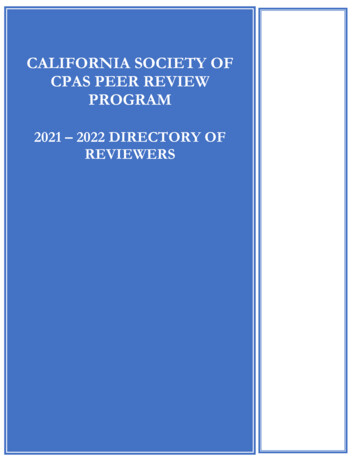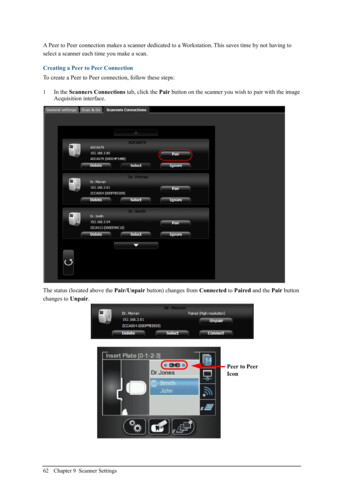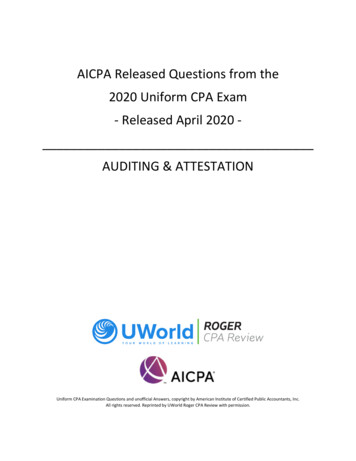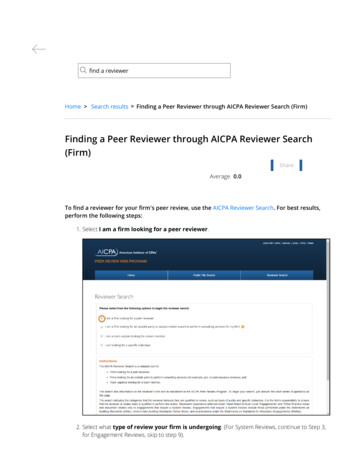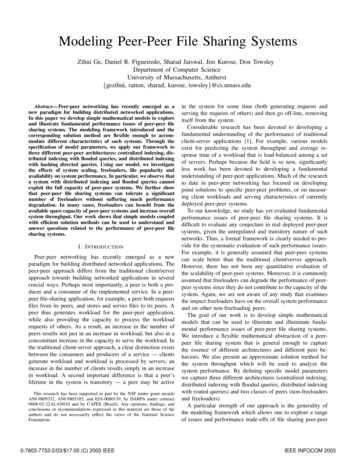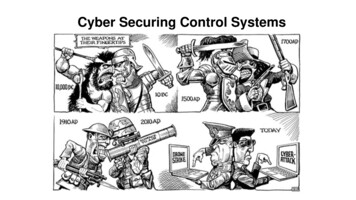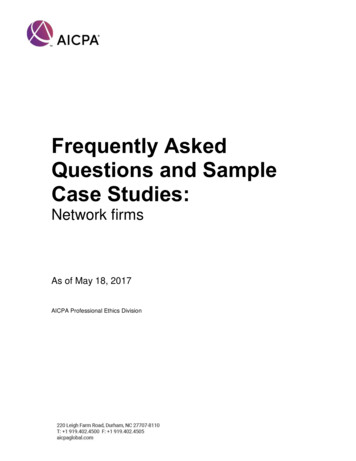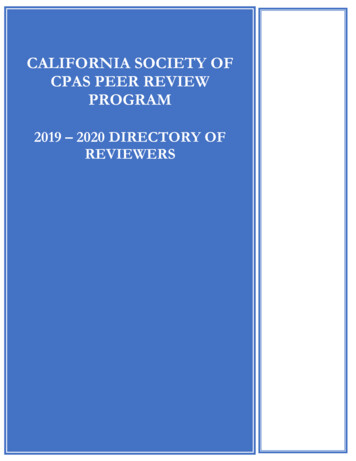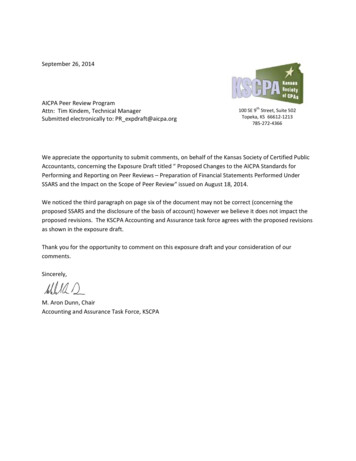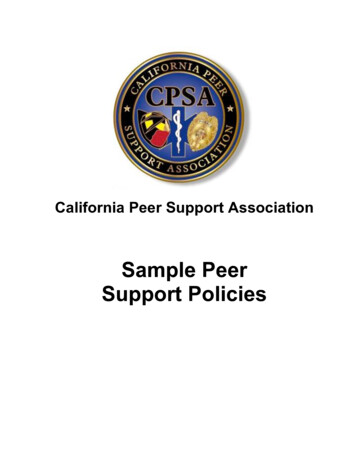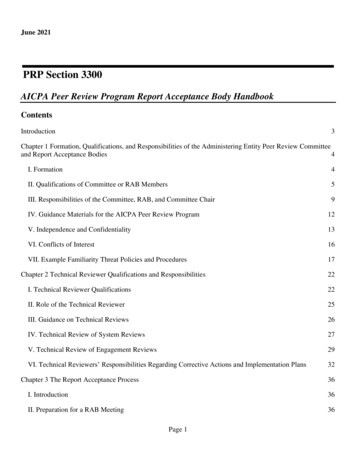
Transcription
June 2021PRP Section 3300AICPA Peer Review Program Report Acceptance Body HandbookContentsIntroduction3Chapter 1 Formation, Qualifications, and Responsibilities of the Administering Entity Peer Review Committeeand Report Acceptance Bodies4I. Formation4II. Qualifications of Committee or RAB Members5III. Responsibilities of the Committee, RAB, and Committee Chair9IV. Guidance Materials for the AICPA Peer Review Program12V. Independence and Confidentiality13VI. Conflicts of Interest16VII. Example Familiarity Threat Policies and Procedures17Chapter 2 Technical Reviewer Qualifications and Responsibilities22I. Technical Reviewer Qualifications22II. Role of the Technical Reviewer25III. Guidance on Technical Reviews26IV. Technical Review of System Reviews27V. Technical Review of Engagement Reviews29VI. Technical Reviewers’ Responsibilities Regarding Corrective Actions and Implementation Plans32Chapter 3 The Report Acceptance Process36I. Introduction36II. Preparation for a RAB Meeting36Page 1
III. Review Acceptance Considerations38IV. Additional Inquiries or Actions by the RAB41V. Criteria for Delayed Acceptance or Deferral42VI. Reference Materials for RAB Meetings44VII. Considerations for the Recall of Peer Review Documents45Chapter 4 Objectives, Overview of System Review Process, and Evaluation and Acceptance of System Reviews67I. Objectives of a System Review67II. Expanded Overview of Objectives on a System Review and Where Team Captains and Report AcceptanceBodies Need to Focus68III. System Review Process69IV. Types and Consideration of Reports to Issue in a System Review73V. Guidance for Determining When and What Type of Corrective Action(s) or Implementation Plans toRequire on System Reviews74Chapter 5 Objectives, Engagement Selection Process, Evaluation, and Acceptance of an Engagement Review 91I. Objectives of an Engagement Review91II. Process a Review Captain Follows in Selecting, Evaluating, and Concluding on the EngagementsReviewed in an Engagement Review91III. Actual Review and Evaluation of Engagements and Other Documents94IV. Types and Consideration of Reports to Issue in an Engagement Review96V. Acceptance of Engagement Reviews by Technical Reviewer97VI. Guidance for Determining When and What Type of Corrective Action(s) or Implementation Plans toRequire on Engagement Reviews99Chapter 6 Monitoring Corrective Actions and Implementation Plans113Corrective Actions113I. Monitoring Process113II. Requiring Additional Corrective Actions114Page 2
June 2021III. Guidance When a Corrective Action Should be Replaced or Waived116IV. Determining Noncooperation of Reviewed Firms118Implementation Plans124I. Monitoring Process124II. Requiring Additional Implementation Plans125III. Guidance When an Implementation Plan Should Be Replaced or Waived126IV. Determining Noncooperation of Reviewed Firms128Chapter 7 Consultations and Disagreements130I. Consultations130II. Disagreements133III. Disagreement Panels134IV. Appeals of Disagreement Panel Decisions136V. Noncooperation136Chapter 8 Reviewer Qualifications, Responsibilities, and Performance137I. Overview137II. Reviewer Qualifications138III. Responsibility to Perform in a Timely and Professional Manner144IV. Reviewer Performance150V. Reviewer Qualifications—Allegations, Investigations, or Limitations or Restrictions165VI. AICPA Peer Review Board Hearing Panel and Ad Hoc Committee Procedures176IntroductionPurposePage 3
The AICPA Peer Review Program Report Acceptance Body Handbook (RAB handbook) contains guidance developed by the AICPA Peer Review Board (board) to be used by administrators, administeringentities peer review committees (committees), report acceptance bodies (RABs), technical reviewers,and reviewers. This handbook should be used in conjunction with the AICPA Standards for Performingand Reporting on Peer Reviews (standards), interpretations, other guidance, the AICPA Peer ReviewProgram Administrative Manual, and the AICPA Peer Review Program Oversight Handbook. Thishandbook has been approved by the board and should be relied upon as guidance for the topics it covers.ObjectivesThe objective of the RAB handbook is to provide guidance to committees, RABs, technical reviewers,and reviewers about their roles and responsibilities regarding the administration, acceptance, and completion of peer reviews.Content and UseThe first two chapters focus on the qualifications and responsibilities of the administering entity peer review committee (chapter 1) and technical reviewers (chapter 2).Chapter 3 explains the report acceptance process, beginning with preparing for the RAB meeting andoutlining the items which must be considered for all reviews. The specific considerations concerning objectives; discussion of the engagement selection process; and evaluation and acceptance of reviews, including considerations of when and what type of corrective action(s) or implementation plans might berequired are covered in chapter 4 (System Reviews) and chapter 5 (Engagement Reviews). Chapter 6contains guidance for monitoring corrective action(s), determining when to require additional correctiveactions when actions previously requested of the firm have been completed, and how to proceed when afirm cannot complete the required corrective action(s) or refuses to cooperate.Chapter 7 discusses when and how to handle consultations and disagreements that may arise during thepeer review process among the reviewed firm, reviewer, and administering entity. Chapter 8 explains thereviewer performance evaluation process and how to handle reviewer noncooperation matters.The RAB handbook guidance does not contain all the standards and interpretations but references keysections to assist in the implementation of guidance and its understanding by committees, RABs, technical reviewers, and reviewers. Administering entities are expected to use the RAB handbook to ensurethat their administration of the AICPA Peer Review Program (program) complies with the standards andinterpretations.Chapter 1Formation, Qualifications, and Responsibilities of the Administering Entity Peer ReviewCommittee and Report Acceptance BodiesI. FormationAn administering entity appoints a peer review committee to oversee the administration, acceptance, andcompletion of peer reviews. The committee may decide to delegate a portion of the report acceptancePage 4
June 2021function to report acceptance bodies (RABs), whose members are not required to be, but may be, members of the committee as well (sec. 1000, Standards for Performing and Reporting on Peer Reviews, par.132). It is recommended that the administering entity document its committee and RAB structure andrelationship.Individuals that commence, or plan to commence, enforcementfn1 related work as a member, employee,consultant, volunteer (or other similar arrangement) of the AICPA or state CPA society ethics committee, the AICPA Joint Trial Board, a state board of accountancy (or other regulatory agencies, governmental bodies or similar groups or subgroups) are prohibited from serving on a committee or RAB.An individual should contact his or her relevant administering entity or AICPA peer review staff if thereis uncertainty as to whether he or she may be prohibited from serving on a peer review committee orRAB.II. Qualifications of Committee or RAB MembersMembers of a committee or a RAB must meet minimum qualification requirements as prescribed in thestandards and interpretations.A. Committee MembersA majority of the peer review committee members and the chairperson charged with the overallresponsibility for administering the program at the administering entity should possess the qualifications required of a team captain in a System Review. (Interpretation No. 132-1 of par. .132 inPRP sec. 1000, Standards for Performing and Reporting on Peer Reviews [PRP sec. 2000]).All committee members must be AICPA members in good standing, whether conducting committee member duties for firms with or without AICPA members. A committee member who issuspended or restricted from scheduling or performing peer reviews no longer meets the qualifications until such suspension or restriction is removed. If a committee member’s ability to perform peer reviews has been restricted as a result of an investigation performed by a regulatoryagency such as AICPA’s Professional Ethics Team (“Ethics”), the extent of the restriction willdetermine whether the individual meets the qualifications to be a committee member.Total RestrictionA total restriction prohibits an individual from performing peer reviews in any capacity. If a totalrestriction is imposed, the individual no longer meets the qualifications and may not serve as acommittee member until such restriction is removed.fn1Performing duties within the framework of peer review is not considered enforcement related workPage 5
Limited RestrictionA limited restriction prohibits an individual from performing peer reviews in a specific capacitysuch as a limitation in a specific industry or engagement type (e.g. employee benefit plans or audits). If a limited restriction is imposed, the Oversight Task Force (OTF) will perform an assessment to evaluate the effect of the limited restriction on the individual’s ability to serve as acommittee member. The assessment includes, but is not limited to, understanding the nature ofthe investigation that led to the limited restriction and the conclusions of the investigation.Reinstatement as a committee member would be at the discretion of the administering entity(AE) or committee if the restriction imposed by the regulatory agency has been removed.B. RAB Members1. Each member of an administering entity’s report acceptance body charged with the responsibility for acceptance of peer reviews must (Interpretation No. 132-1)a. be currently active in public practice at a supervisory level in the accounting orauditing function of a firm enrolled in the program, as a partner of the firm, or asa manager or person with equivalent supervisory responsibilities. To be considered currently active in the accounting or auditing function, a report acceptancebody member should be presently involved in the accounting or auditing practiceof a firm supervising one or more of the firm’s accounting or auditing engagements or carrying out a quality control function on the firm’s accounting or auditing engagements (Interpretation No. 132-1a).b. be associated with a firm (or all firms, if associated with more than one firm) thathas received a report with a peer review rating of pass on its most recently accepted System or Engagement Review that was accepted timely, ordinarily withinthe last three years and six months (Interpretation No. 132-1b).c. if the member is from a firm that is a provider of quality control materials (QCM)or is affiliated with a provider of QCM and is required to have a QCM review under the standards, be associated with a provider firm or affiliated entity that hasreceived a QCM report with a review rating of pass for its most recent QCM review that was submitted timely, ordinarily within six months of the provider’syear-end.d. demonstrate proficiency in the standards, interpretations, and guidance of the program by completing training that meets the team captain training requirements established by the board within 12 months prior to serving on the committee or during the first year of service on the committeefn 2 The peer review training and thecriteria for demonstrating proficiency in the standards, interpretations, and guid-fn2See Interpretation No. 33-1.Page 6
June 2021ance of the program is established from time to time by the board. Those criteriaare located on the Peer Review page of the AICPA website. (Interpretation No.132-1c).e. demonstrate proficiency in the standards, interpretations, and guidance of the program by completing an introductory RAB training course developed by theAICPA, ordinarily within 12 months prior to serving on a RAB. This course is designed to cover the responsibilities of RAB members and address frequentlyasked questions of experienced RAB members. It will also address how recentchanges in peer review guidance impact the RAB process. (Interpretation No.132-1c).f. be an AICPA member in good standing, whether conducting report acceptancebody member duties for firms with or without AICPA members. (InterpretationNo. 132-1d).g. at least one member of the RAB considering a peer review that includes (1) engagements performed under Government Auditing Standards (GAS, also knownas the Yellow Book) including engagements performed subject to the Single Audit Act (also known as Single Audits), (2) audits of employee benefit plans conducted pursuant to the Employee Retirement Income Security Act of 1974(ERISA), (3) audits of a federally insured depository institution (FDICIA) havingtotal assets of 500 million or greater at the beginning of its fiscal year, or (4) examinations of service organizations (SOC 1 and SOC 2 engagements) musthave current experience in such engagements or a national RAB consultant withthe applicable experience may be utilized.2. The committee and RABs should have broad industry knowledge in the specialized industries served by firms whose reviews are under consideration. However, it is unnecessary for all committee or RAB members considering such firms ’reviews to haveknowledge in these specialized industries.3. A majority of the RAB members and the chairperson charged with the responsibility foracceptance of System Reviews should possess the qualifications required of a SystemReview team captain. (Interpretation No. 132-1).A RAB member who is suspended or restricted from scheduling or performing peer reviews no longer meets the qualifications until such suspension or restriction is removed.If an individual’s ability to perform peer reviews has been restricted as a result of an investigation performed by a regulatory agency, such as Ethics, the extent of the restrictionwill determine whether the individual may serve as a RAB member.The descriptions and effects of total and limited restrictions above in II Qualifications ofCommittee or RAB Members, A. Committee Members applies to the qualifications of anindividual to serve as a RAB member.Page 7
Reinstatement as a RAB member would be at the discretion of the AE or committee if therestriction imposed by the regulatory agency has been lifted.C. National RAB ListA national list of consultants will be maintained by the AICPA, so that the administering entityhas an available pool of consultants with GAS, ERISA, FDICIA, and SOC 1 and SOC 2 engagements experience to call upon in the instance when it does not have an experienced RABmember to consider the review of a firm when circumstances warrant (see the preceding (B)(2))The national RAB consultant would not necessarily have to physically participate in the RABmeeting (teleconference option). The national RAB consultant will not be eligible to vote on theacceptance of a review. Determination that a review requires a national RAB consultant shouldbe made prior to assigning the review to a RAB. The national RAB consultant would have tomeet the following qualifications for RAB participation:1. Currently active in public practice at a supervisory level in the accounting or auditingfunction of a firm enrolled in the program, as a partner of the firm, or as a manager orperson with equivalent supervisory responsibilities. To be considered currently active, aconsultant should be presently involved in the supervision of one or more of his or herfirm’s accounting or auditing engagements or carrying out a quality control function onthe firm’s accounting or auditing engagements. To be considered a consultant on GAS,ERISA, FDICIA, or SOC 1 or SOC 2 engagements, the current activity must includethe respective industry asked to consult upon.2. Associated with a firm (or all firms, if associated with more than one firm) that has received a report with a peer review rating of pass on its most recently accepted SystemReview that was accepted timely, ordinarily within the last three years and six months.3. Not associated with an engagement that was deemed not performed in accordance withprofessional standards on the consultant’s firm’s most recently accepted System Review.4. Be an AICPA member in good standing whether conducting consultant duties for firmswith or without AICPA members.5. To be considered a consultant on SOC 1 or SOC 2 engagements:a. Possess current knowledge of professional standards applicable to SOC 1 orSOC 2 examinations, including Type 1 and Type 2 reports, qualified and unqualified reports, carve in or carve out engagements, and engagements with and without relevant user entity controls.b. Have at least five years of recent experience in the practice of public accountingwith a minimum of 500 hours of SAS 70/SOC 1 or SysTrust/SOC 2 examinations.c. Have provided the administering entity with information that accurately reflectsthe qualifications of the specialist, which is updated on a timely basis.Page 8
June 2021III. Responsibilities of the Committee, RAB, and Committee ChairOverall General Responsibilities of the CommitteeThe peer review committee has the responsibility to oversee the program administered by its administering entity. That includes, but is not limited to, the following:A. Oversee the peer reviews administered and performed in that state or in other states it has agreedto administer.B. Establish procedures to ensure consistent application of the standards, interpretations, and otherguidance related to overdue reviews, corrective actions, and plans to implement or complete corrective actions. The committee should periodically receive current statistical and other information on these matters from the administering entity staff.C. Establish a comprehensive and written oversight program to ensure the program is performed inaccordance with standards and guidance issued by the board. Administering entities are requiredto submit their oversight policies and procedures to the board on an annual basis. In conjunctionwith the administering entity personnel, the peer review committee establishes oversight policiesand procedures that at least meet the minimum requirements established by the board. TheAICPA Peer Review Program Oversight Handbook contains a detailed discussion of the minimum oversight requirements and the entire oversight process.D. Review the adequacy of the back-up plan for key individuals (administrators and technical reviewers) involved in the administration of the program.E. Form panels to address disagreements between the committee, peer review teams, and reviewedfirms, referring instances of noncooperation to the board where appropriate.F. Act upon requests from firms for changes in the timing and year-ends of their reviews.G. Appoint persons to serve on committees and task forces as necessary to carry out its functions.H. Monitor reviews that should have been performed but have not commenced or been finished,those in process not yet presented to the committee or RAB, and those that have been presentedto the committee or RAB that have overdue corrective actions or otherwise where the firm maynot be cooperating with the committee.I. Monitor the reviewers performing reviews within their jurisdiction. This includes identifyingwhen a reviewer is not fulfilling qualifications and all reviewer responsibilities in the performance of reviews. If the reviewer fails to maintain qualifications or responsibilities, the committee has the duty to determine if corrective actions or restrictions should be placed upon the reviewer.J. Monitor performance of reviewers that have corrective actions or restrictions to determine ifsuch actions or restrictions should be lifted or modified. If no improvement or lack of cooperaPage 9
tion is evident, the committee should request the board consider placing a national restriction orsome other action on the reviewer.K. Establish procedures that ensure fair procedures for reviewers that have disagreements with theadministering entity.L. Recommend to the Executive Committee (Board of Directors) of the administering entity policies governing the administration of the peer review program.M. Evaluate the qualifications and competencies of the technical reviewers on an annual basis togive technical reviewers positive and constructive feedback.Responsibility for Reviews Performed by Reviewers or Firms That Have Been Limited or RestrictedAEs and their peer review committees (PRCs) have a professional responsibility to ensure that reviewsare being performed by qualified peer reviewers and reviewing firms and that they are addressing publicinterest concerns when considering any peer review documents for acceptance where the peer revieweror reviewing firm has had a limitation or restriction placed. AEs and their PRCs will rely on varioussources for information on limitations or restrictions that have been imposed, including the peer reviewer or reviewing firm’s own professional responsibility in accordance with the AICPA Peer Review Program’s Standards and Interpretations to inform the AICPA technical staff of such communications ornotifications.Report Acceptance ResponsibilitiesIt is ultimately the committee’s responsibility to ensure that it (or a RAB on its behalf) considers the results of peer reviews it administers that are undertaken to meet the requirements of the program (sec.1000 par. .132). RABs should periodically report their decisions regarding acceptance and related conclusions to the committee.RABs should be structured such that they may refer difficult or problem reviews to the committee foracceptance or concurrence, or both.The committee’s report acceptance body’s responsibilities include, but are not limited to the following(sec. 1000 par. .133):A. Ensure that peer reviews are presented to a RAB in a timely manner, ordinarily within 120 daysof the receipt of the working papers, peer review report, and letter of response, if applicable,from the team captain or review captain, or within 60 days for Engagement Reviews meetingcertain criteria (see chapter 2, section V.B) (sec. 1000 par. .133a). Timely acceptance of peer reviews is important because delays may affect both the firm and peer reviewers within the firm.However, there are circumstances in which delays are unavoidable, including the following:1. Determination during technical review or presentation than an oversight should be performed2. Submitted peer review documentation requires significant revisionsPage 10
June 20213. Additional inquiries of the firm or peer review team as a result of the technical review orpresentation4. Enhanced oversight procedures5. Disagreements between reviewer, reviewed firm and RABB. Consider whether the review has been performed in accordance with the standards, interpretations, and related guidance materials (sec. 1000 par. .133b).C. Consider whether the report and the response thereto, if applicable, are in accordance with thestandards, interpretations, and related guidance materials, including an evaluation of the adequacy of the corrective actions the reviewed firm has represented that it has taken or will take in itsletter of response, if any (sec. 1000 par. .133c).D. Determine whether it should require any remedial, corrective actions related to the deficienciesor significant deficiencies noted in the peer review report, in addition to those described by thereviewed firm in its letter of response. Examples of such corrective actions include, but are notlimited to, requiring certain individuals to obtain specified kinds and specified amounts of continuing professional education (CPE), requiring the firm to carry out comprehensive monitoringprocedures, or requiring the firm to engage another CPA to perform pre-issuance or postissuance reviews of financial statements, reports, and accounting and audit documentation to attempt to strengthen the performance of the firm’s personnel (sec. 1000 par. .133d).E. In relation to Finding for Further Consideration (FFC)1. consider whether FFC (and associated Matter for Further Consideration [MFC] and Disposition of Matter for Further Consideration [DMFC]) forms are prepared in accordancewith the standards, interpretations, and related guidance materials, including whether thefindings addressed on the FFC forms should have been included in a report with a peerreview rating of pass with deficiencies or fail (sec. 1000 par. .133e1).2. determine the adequacy of the plan the reviewed firm has represented it has implementedor will implement in its response on the FFC form(s) (sec. 1000 par. .133e2).3. determine whether it should require an implementation plan in addition to or as an affirmation of the plan described by the reviewed firm in its response to findings on the FFCform(s) (sec. 1000 par. .133e3).F. Ensure that all corrective actions related to deficiencies or significant deficiencies in the peer review report and all implementation plans related to findings on FFC forms have been completedto the satisfaction of the committee (sec. 1000 par. .133f).G. Ensure that all firms within its jurisdiction have timely peer reviews and keep track of the timingof the completion of corrective actions and plans to implement corrective actions by all firms forPage 11
which the committee has required corrective actions, including those that are overdue (sec. 1000par. .133g).Peer Review Committee Chair ResponsibilitiesThe committee chair has overall responsibility to ensure the administering entity adheres to all of the responsibilities previously outlined. The chair shouldA. consult with the staff (including AICPA staff) and committee members, as needed.B. stimulate group thinking, encourage and channel discussions in a productive direction, weigh thevalue of expressed ideas and suggestions, summarize constructive suggestions, seek out decisions, avoid situations where one or two people dominate the discussion inappropriately, andkeep committee meetings on target and within reasonable time limits.C. ensure that accurate meeting minutes are kept, necessary reports prepared, and a record of committee work maintained, and keep informed of the progress of committee assignments.D. recommend appropriate members for appointment to the committee; select appropriate committee members to serve on RABs, subcommittees, and task forces; and motivate them toward active and productive involvement in committee activities.E. continually review and evaluate the committee’s program, the progress being made on activities,and the contributions of individual committee members and the technical reviewer(s) to thecommittee’s work.F. be a consultant or mentor to reviewers and firms undergoing review.G. review the comments received from the AICPA Peer Review Board Oversight Task Force on reviews selected for oversight by AICPA staff. Communicate the comments to the committee,technical reviewers, administrators, oversight reviewer (if applicable), and team captain or review captain where appropriate. A procedure to review and properly act upon each commentshould be developed. The comments may be used by the administering entity in monitoring performance and consideration should be given to sending appropriate performance feedback to theteam captain or review captain and technical reviewer.IV. Guidance Materials for the AICPA Peer Review ProgramThe activities of the committee and RABs should be carried out in accordance with administrative procedures and guidance issued by the board (sec. 1000 par. .132). In order to assist committee and RABmembers in adhering to the guidance, they should have access to the applicable and appropriate materials to carry out their responsibilities.A. AICPA Peer Review Program ManualThe current standards, interpretations, guidelines, peer review checklists, and other guidance materials developed by the board for the administration, performance, and reporting the results ofpeer reviews are contained in the AICPA Peer Review Program Manual.Page 12
June 2021B. AICPA Peer Review Program Report Acceptance Body HandbookThe AICPA Peer Review Program Report Acceptance Handbook should be used by committees,RABs, technical reviewers, and administrators in the administration, acceptance, and completionof peer reviews. The manual is updated as necessary and is included as section 3300 of theAICPA Peer Review Program Manual.C. AICPA Peer Review WebsiteAdditional guidance that should be considered by reviewers and administering entities also appears on the AICPA peer review website at www.aicpa.org/interestareas/peerreview.html.D. AICPA Peer Review Program Administrative ManualThe AICPA Peer Review Program Administrative Manual should be used as guidance and a reference tool for those administering the program. The manual is updated as necessary and madeavailable to approved administering entities and located on the AICPA SharePoint extranet.E. AICPA Peer Review Program Oversight HandbookThe AICPA Peer Review Program Oversight Handbook should be used as guidance and a reference tool related to the oversight procedures performed on the program. The manual is updatedas necessary and made available to approved administering entities and located on the AICPASharePoint extranet.F. Annual Report on OversightThe AICPA Peer Review Board Oversight Task Force issues an Annual Report on Oversight.The purpose of the report is to provide a general overview; past and current statistics and information; the results of the various oversight procedures performed on the program; and to conclude on whether the objectives of the board’s oversight process were met. The report is available on the AICPA website.V. Independence and ConfidentialityIndependence, in fact and in appearance, should be maintained with respect to the reviewed firm by areviewing firm, by review team members, a
II. Process a Review Captain Follows in Selecting, Evaluating, and Concluding on the Engagements Reviewed in an Engagement Review 91 III. Actual Review and Evaluation of Engagements and Other Documents 94 IV. Types and Consideration of Reports to Issue in an Engagement Review 96 V. Acceptance of Engagement Reviews by Technical Reviewer 97 VI.
